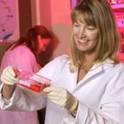
DNA nanotechnology holds the potential for enabling new tools for biomedical engineering, including diagnosis, prognosis, and therapeutics. However, applications for DNA devices are thought to be limited by rapid enzymatic degradation in serum and blood. Here, we demonstrate that a key aspect of DNA nanotechnology—programmable molecular shape—plays a substantial role in device lifetimes. These results establish the ability to operate synthetic DNA devices in the presence of endogenous enzymes and challenge the textbook view of near instantaneous degradation.
This document was originally published by Royal Society of Chemistry Publishing in Nanoscale. This work is provided under Creative Commons Attribution License 3.0. Details regarding the use of this work can be found at: http://creativecommons.org/licenses/by/3.0/. doi: 10.1039/C5NR02283E
Available at: http://works.bepress.com/cheryl_jorcyk/32/

For complete list of authors, please see article.